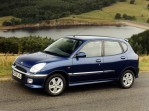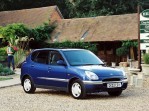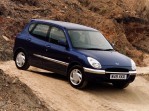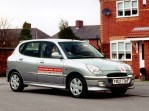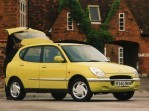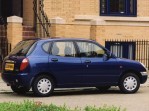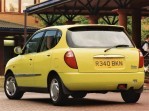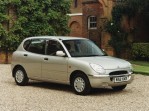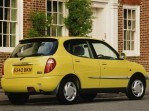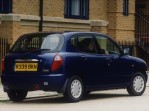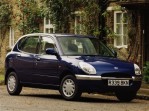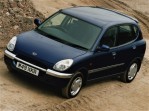Body style: Hatchback
Segment: Small
Production years: 1998, 1999, 2000, 2001, 2002
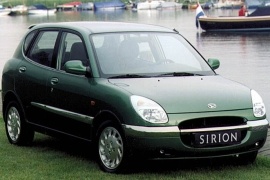 16 Photos
16 PhotosDaihatsu's expertise in small cars was obvious, and it introduced the Sirion in 1998 as a sub-compact segment vehicle and exported it from Japan.
Even though the Charade name was better-known, Daihatsu made a bold decision and changed the lineup name instead of just call it a new generation. But it was more than just a new model; it was a new concept. The car aimed to a higher level, with better-equipped vehicles. It wasn't just a box on the wheels anymore, or, at least, it tried not to.
Daihatsu was slow in the decision to implement the bio-design trend on its lineup, but the Sirion adopted it. It featured tear-shaped, swept-back headlights with the turn signals mounted on their upper sides. A rounded grille crossed by a horizontal slat filled most of the area between the headlamps, and the carmaker found a way to install two fog lights on the lower side of the bumper. From its sides, the Sirion surprised the customers with its curved ascending beltline over the rear doors and the last row of windows placed behind them. In the back, the sub-compact car featured similar tear-shaped taillights as the headlights.
Inside, the Sirion offered room for four adults, ending the "fourish" roominess of the Charade's interiors. The dashboard was clearly a big step forward with an advanced design. Its instrument panel and center stack shared the same cover that continued on the passenger's side with an open storage area. Since Daihatsu was part of the Toyota Motor Corporation, it took some ideas from its bigger brother and installed the climate controls above the stereo.
Under the hood, the carmaker installed a choice of two engines, both running on gasoline. Daihatsu paired them with a five-speed manual gearbox.
DAIHATSU Sirion 1998, 1999, 2000, 2001, 2002
- 1.0L 5MT FWD (55 HP)
- 1.3L 5MT FWD (101 HP)
DAIHATSU Sirion
1.0L 5MT FWD (55 HP)
ENGINE SPECS - 1.0L 5MT FWD (55 HP) | |
|---|---|
| Cylinders: | L3 |
| Displacement: | 989 cm3 |
| Power: | 40 KW @ 5200 RPM 54 HP @ 5200 RPM 54 BHP @ 5200 RPM |
| Torque: | 65 lb-ft @ 3600 RPM 88 Nm @ 3600 RPM |
| Fuel System: | Multipoint Injection |
| Fuel: | Gasoline |
| Fuel capacity: | 9.8 gallons (37.1 L) |
PERFORMANCE SPECS | |
|---|---|
| Top Speed: | 90.1 mph (145 km/h) |
| Acceleration 0-62 Mph (0-100 kph): | 15.4 s |
TRANSMISSION SPECS | |
|---|---|
| Drive Type: | Front Wheel Drive |
| Gearbox: | 5-Speed manual |
BRAKES SPECS | |
|---|---|
| Front: | Discs |
| Rear: | Drums |
TIRES SPECS | |
|---|---|
| Tire Size: | 145/80R13 |
DIMENSIONS | |
|---|---|
| Length: | 144.9 in (3680 mm) |
| Width: | 63 in (1600 mm) |
| Height: | 57.1 in (1450 mm) |
| Front/rear Track: | 55.1/54.3 in (1,400/1,379 mm) |
| Wheelbase: | 92.1 in (2339 mm) |
| Ground Clearance: | 5.5 in (140 mm) |
| Cargo Volume: | 8.3 cuFT (235 L) |
WEIGHT SPECS | |
|---|---|
| Unladen Weight: | 1730.6 lbs (785 kg) |
| Gross Weight Limit: | 2910.1 lbs (1320 kg) |
FUEL ECONOMY (NEDC) | |
|---|---|
| City: | 35.6 mpg US (6.6 L/100Km) |
| Highway: | 49 mpg US (4.8 L/100Km) |
| Combined: | 42.8 mpg US (5.5 L/100Km) |
| CO2 Emissions: | 131 g/km |
DAIHATSU Sirion
1.3L 5MT FWD (101 HP)
ENGINE SPECS - 1.3L 5MT FWD (101 HP) | |
|---|---|
| Cylinders: | L4 |
| Displacement: | 1298 cm3 |
| Power: | 75 KW @ 7000 RPM 102 HP @ 7000 RPM 101 BHP @ 7000 RPM |
| Torque: | 89 lb-ft @ 4400 RPM 120 Nm @ 4400 RPM |
| Fuel System: | Multipoint Injection |
| Fuel: | Gasoline |
| Fuel capacity: | 9.8 gallons (37.1 L) |
PERFORMANCE SPECS | |
|---|---|
| Top Speed: | 111.8 mph (180 km/h) |
| Acceleration 0-62 Mph (0-100 kph): | 9.6 s |
TRANSMISSION SPECS | |
|---|---|
| Drive Type: | Front Wheel Drive |
| Gearbox: | 5-Speed manual |
BRAKES SPECS | |
|---|---|
| Front: | Discs |
| Rear: | Drums |
TIRES SPECS | |
|---|---|
| Tire Size: | 165/65R14 |
DIMENSIONS | |
|---|---|
| Length: | 144.9 in (3680 mm) |
| Width: | 63 in (1600 mm) |
| Height: | 57.1 in (1450 mm) |
| Front/rear Track: | 55.1/54.3 in (1,400/1,379 mm) |
| Wheelbase: | 92.1 in (2339 mm) |
| Ground Clearance: | 5.5 in (140 mm) |
| Cargo Volume: | 8.3 cuFT (235 L) |
WEIGHT SPECS | |
|---|---|
| Unladen Weight: | 1873.9 lbs (850 kg) |
| Gross Weight Limit: | 2910.1 lbs (1320 kg) |
FUEL ECONOMY (NEDC) | |
|---|---|
| City: | 30.9 mpg US (7.6 L/100Km) |
| Highway: | 51.1 mpg US (4.6 L/100Km) |
| Combined: | 41.3 mpg US (5.7 L/100Km) |
| CO2 Emissions: | 154 g/km |




